Salamiyya, Syria.
Salamiyya, Syria.
Peaceful Times and Fond Memories of Salamiyya, Syria….Then Terror Strikes Violating the Qur’anic Injunctions on the Sanctity of Life
simergphotos.com/2013/01/29/peaceful-times-and-fond-memories-of-salamiyya-syria-then-terror-strikes-violating-the-quranic-injunctions-on-the-sanctity-of-life/
simergphotos.com/2013/01/29/peaceful-times-and-fond-memories-of-salamiyya-syria-then-terror-strikes-violating-the-quranic-injunctions-on-the-sanctity-of-life/
2001 Visit by Mowlana Hazar Imam in Syria. Mowla gave Didar in Salamieh and in Al-Khawabieh.
Link:
http://www.ismaili.net/Syria/index.html
Link:
http://www.ismaili.net/Syria/index.html
Excellent pictures thanks for sharing
In times of difficulty, these images bridge the gaps of distance and time. May their hard time be eased, Amen.
We pray for our brothers and sisters and feel their pain and sorrow and wish we could do more.
INSHA ALLAH Syria and other countries will return to peace.
In times of difficulty, these images bridge the gaps of distance and time. May their hard time be eased, Amen.
We pray for our brothers and sisters and feel their pain and sorrow and wish we could do more.
INSHA ALLAH Syria and other countries will return to peace.
70 Ismailis died around Salamieh last night inattack by ISIS
Date: Sat, 21 Mar 2015 14:29:35 +0200
Ya Ali Madat all
ALL THE DAY OF NAVROZ
I am not sure that we can respond to the nice wishes of 21 of March 2015 which is (Mother’s Day and Nuvroz Day) due to losing more than 70 lovely young men at my lovely hometown (SALAMIEH) last night. Death to collaborate with IS took all their hopes of the future and left their love ones and families with pain, sorrow and lost hope. IS launched a severe attack on several locations east of rural Salamieh
Mothers in Salamieh are so sad for losing their lovely young men, families are sad even the trees, streets and stones are sad. Salamieh is dressed in black instead of the green. There is no spring at my lovely hometown.
I am really sorry to inform you about this, but it is important to know about. So may you pay for their souls to rest in peace and pray for the families inside Salamieh for better future and spring better than this. Please speak up loudly during your prayer tonight. May your prayers with ours can open the sky for peace in Salamieh and Syria, as well.
Dear brothers and sisters, please transfer this msg to all ismailis around the world. We are peaceful people we want to live in peace. We are against all kinds of wars. We want to practice our lives normally. PLEASE DON'T IGNORE THIS. WE ARE PEACEFUL PEOPLE.
Let’s pray tonight for the rest of those young men souls and god bless them all, wishing at the same the end of this misery soon.
Now, Navroz Mubark for all Ismailis and every one of you
Jalal Kaddaha
Ya Ali Madat all
ALL THE DAY OF NAVROZ
I am not sure that we can respond to the nice wishes of 21 of March 2015 which is (Mother’s Day and Nuvroz Day) due to losing more than 70 lovely young men at my lovely hometown (SALAMIEH) last night. Death to collaborate with IS took all their hopes of the future and left their love ones and families with pain, sorrow and lost hope. IS launched a severe attack on several locations east of rural Salamieh
Mothers in Salamieh are so sad for losing their lovely young men, families are sad even the trees, streets and stones are sad. Salamieh is dressed in black instead of the green. There is no spring at my lovely hometown.
I am really sorry to inform you about this, but it is important to know about. So may you pay for their souls to rest in peace and pray for the families inside Salamieh for better future and spring better than this. Please speak up loudly during your prayer tonight. May your prayers with ours can open the sky for peace in Salamieh and Syria, as well.
Dear brothers and sisters, please transfer this msg to all ismailis around the world. We are peaceful people we want to live in peace. We are against all kinds of wars. We want to practice our lives normally. PLEASE DON'T IGNORE THIS. WE ARE PEACEFUL PEOPLE.
Let’s pray tonight for the rest of those young men souls and god bless them all, wishing at the same the end of this misery soon.
Now, Navroz Mubark for all Ismailis and every one of you
Jalal Kaddaha
Last edited by Admin on Sat Mar 28, 2015 9:13 am, edited 1 time in total.
AS RECEIVED
Press ? for keyboard shortcuts.
> from M/K of Gothenburg:
> Ya Ali Madad
>
> We pray all is very well with you and your families
>
>
>
> Navroz Mubarak. We wish you and your families Baraka Wa Baraka!
>
> It is with profound sadness that we inform the Jamaat, the Navroz celebrations scheduled to take place in Gothenburg on Saturday 28 March, with much disappointment, unfortunately has been cancelled.
>
>
>
> Reason! Due to the horrifying situation in Salamiyah, Syria. 75 of Salamiyah's Jamaati members were murdered by IS - terrorists on Friday. Many of those murdered, have family members in Sweden.
>
>
>
> Special prayers will be recited in Sweden Jamaat Khaana's. Mukni/ani & Kamadia/ani Request the Jamaat to attend Jamaat Khaana in large numbers to pray for the souls of the deceased and for strength for all the family members
>
>
>
> At this time of sorrowful and immeasurable loss, our considerate thoughts, dedicated prayers and humble supplications are with the immediate family, members of the deceased.
>
> Our prayers to Hazer Imam for the peaceful rest of the souls of the deceased and strength for all the family members.
>
>
> May Mowla grant you & your families with immense happiness, excellent health, success in all your noble endeavours and the fulfilment of all your good wishes. May Mowla accept your wonderful, self-less service and continue to bless you & your family with lots of spiritual & material baraka , strength, courage and inspiration to continue to serve Him & His Jamat with love, affection, unity & immense success. Amen
( In the name of Allah, the beneficent, the Merciful)
Innalillahi Wa Inna Ilayhi Raaji'oon
To Allah we belong, and to Him is our return. (Al-Baqarah 2:156)
Allah pak marhum ne jannat naseeb kare. Ameen rabbiul alamin.
"And He it is Who in the heaven is God, and in the earth God. He is the Wise, the knower" (Holy Quran; Az-Zukhruf; XLIII:84).
Press ? for keyboard shortcuts.
> from M/K of Gothenburg:
> Ya Ali Madad
>
> We pray all is very well with you and your families
>
>
>
> Navroz Mubarak. We wish you and your families Baraka Wa Baraka!
>
> It is with profound sadness that we inform the Jamaat, the Navroz celebrations scheduled to take place in Gothenburg on Saturday 28 March, with much disappointment, unfortunately has been cancelled.
>
>
>
> Reason! Due to the horrifying situation in Salamiyah, Syria. 75 of Salamiyah's Jamaati members were murdered by IS - terrorists on Friday. Many of those murdered, have family members in Sweden.
>
>
>
> Special prayers will be recited in Sweden Jamaat Khaana's. Mukni/ani & Kamadia/ani Request the Jamaat to attend Jamaat Khaana in large numbers to pray for the souls of the deceased and for strength for all the family members
>
>
>
> At this time of sorrowful and immeasurable loss, our considerate thoughts, dedicated prayers and humble supplications are with the immediate family, members of the deceased.
>
> Our prayers to Hazer Imam for the peaceful rest of the souls of the deceased and strength for all the family members.
>
>
> May Mowla grant you & your families with immense happiness, excellent health, success in all your noble endeavours and the fulfilment of all your good wishes. May Mowla accept your wonderful, self-less service and continue to bless you & your family with lots of spiritual & material baraka , strength, courage and inspiration to continue to serve Him & His Jamat with love, affection, unity & immense success. Amen
( In the name of Allah, the beneficent, the Merciful)
Innalillahi Wa Inna Ilayhi Raaji'oon
To Allah we belong, and to Him is our return. (Al-Baqarah 2:156)
Allah pak marhum ne jannat naseeb kare. Ameen rabbiul alamin.
"And He it is Who in the heaven is God, and in the earth God. He is the Wise, the knower" (Holy Quran; Az-Zukhruf; XLIII:84).
AS RECEIVED
Sadly, the news that you heard are correct. MHI has sent a Farman to our Jamat in Syria following to this deadly event. In these days, each and every family from our jamat in Syria has become bereaved now.
Furthermore, the necessities of life in Salamieh have become very rare. Electricity frequently turns off and on by average of one hour on five hours off. The drinkable water comes to Salamiyeh for few hours a week, and people are buying the water from the neighboring wells.
The prices are prohibitively expensive. The price of the dollar against the Syrian pound is 260 these days, from 45 before the war. The situation in general is not good at all, and what makes you feel more sad that the whole Arab area is deteriorating whether in Iraq, Syria, Egypt, Libia, Yemen and so on.
Sadly, the news that you heard are correct. MHI has sent a Farman to our Jamat in Syria following to this deadly event. In these days, each and every family from our jamat in Syria has become bereaved now.
Furthermore, the necessities of life in Salamieh have become very rare. Electricity frequently turns off and on by average of one hour on five hours off. The drinkable water comes to Salamiyeh for few hours a week, and people are buying the water from the neighboring wells.
The prices are prohibitively expensive. The price of the dollar against the Syrian pound is 260 these days, from 45 before the war. The situation in general is not good at all, and what makes you feel more sad that the whole Arab area is deteriorating whether in Iraq, Syria, Egypt, Libia, Yemen and so on.
AS RECEIVED
Islamic State militants ha killed at least 30 people, including children and women, in a government-held village in central Syria, a monitoring group says.
Some of the victims in Mabouja were burned to death or beheaded, the Syrian Observatory for Human Rights reported.
The state news agency, Sana, said at least eight people were killed, as soldiers repelled a terrorist attack.
Mabouja's population include members of the minority Alawite and Ismaili Muslim sects, which IS considers heretical.
In recent weeks, the jihadist group has mounted numerous attacks in government-held areas in the central provinces of Homs and Hama, where Mabouja is located.
Vital road
The Syrian Observatory, a UK-based group that uses a network of contacts to monitor the four-year-old conflict in the country, said on Tuesday that IS militants had killed Alawite, Ismaili and Sunni residents of Mabouja by "burning, beheading, and firing on them".
A Syrian military source told the Reuters news agency that the jihadists had massacred civilians there, but did not have a number for the dead.
"Daesh tried to attack the village, and this attack was repelled, and a large number of Daesh terrorists were killed. And now the Syrian army is imposing its control over the village," the source said, using a pejorative term for IS based on the acronym of a previous name in Arabic.
"Daesh is making a lot of attempts [to advance] east of Hama. It is trying a lot in that area, particularly after its loss in Shaar [gas] field," he added.
Sana meanwhile reported that soldiers, militiamen and locals had "confronted an assault" launched by terrorist groups against Mabouja".
At least eight people were killed and 18 were injured, it said, adding that the assailants also suffered "heavy losses".
Websites affiliated with IS claimed the village had been "liberated" and that dozens of people had been killed or captured.
Mabouja, about 60km (40 miles) east of Hama, lies near a vital road that serves as the government's only link between Homs province, to the south, and the northern province of Aleppo.
IS militants have attempted several times to gain control over the road, and killed 83 soldiers in an attack in the region in late March.
Islamic State militants ha killed at least 30 people, including children and women, in a government-held village in central Syria, a monitoring group says.
Some of the victims in Mabouja were burned to death or beheaded, the Syrian Observatory for Human Rights reported.
The state news agency, Sana, said at least eight people were killed, as soldiers repelled a terrorist attack.
Mabouja's population include members of the minority Alawite and Ismaili Muslim sects, which IS considers heretical.
In recent weeks, the jihadist group has mounted numerous attacks in government-held areas in the central provinces of Homs and Hama, where Mabouja is located.
Vital road
The Syrian Observatory, a UK-based group that uses a network of contacts to monitor the four-year-old conflict in the country, said on Tuesday that IS militants had killed Alawite, Ismaili and Sunni residents of Mabouja by "burning, beheading, and firing on them".
A Syrian military source told the Reuters news agency that the jihadists had massacred civilians there, but did not have a number for the dead.
"Daesh tried to attack the village, and this attack was repelled, and a large number of Daesh terrorists were killed. And now the Syrian army is imposing its control over the village," the source said, using a pejorative term for IS based on the acronym of a previous name in Arabic.
"Daesh is making a lot of attempts [to advance] east of Hama. It is trying a lot in that area, particularly after its loss in Shaar [gas] field," he added.
Sana meanwhile reported that soldiers, militiamen and locals had "confronted an assault" launched by terrorist groups against Mabouja".
At least eight people were killed and 18 were injured, it said, adding that the assailants also suffered "heavy losses".
Websites affiliated with IS claimed the village had been "liberated" and that dozens of people had been killed or captured.
Mabouja, about 60km (40 miles) east of Hama, lies near a vital road that serves as the government's only link between Homs province, to the south, and the northern province of Aleppo.
IS militants have attempted several times to gain control over the road, and killed 83 soldiers in an attack in the region in late March.
Car bomb blast leaves 4 people dead in western Syria
At least four people have lost their lives and eight others injured in a car bomb explosion in Syria’s Western province of Hama hours after a cessation of hostilities agreement took effect in the country.
The blast rocked a checkpoint on the eastern entrance of the Salamiyah town on Saturday, the official SANA news agency reported.
Two civilians were among those killed in the bombing.
A militant group affiliated with the Takfiri Daesh terrorist group has claimed responsibility for the explosion, according to reports.
The so-called Syrian Observatory for Human Rights also held Daesh responsible for Saturday’s bomb blast.
“The car bomb attack is not a breach to the truce because it occurred in an area where the cessation of hostilities agreement does not apply,” said Rami Abdulrahman, head of the monitoring group.
A second explosion was also reported in the same area, where an explosives-laden motorbike went off. An unspecified number of people were injured in the incident.
Salamiyah is considered as a frontline in battles between Syrian government forces and Daesh Takfiri militants.
More....
http://www.presstv.ir/Detail/2016/02/27 ... Explosion-
At least four people have lost their lives and eight others injured in a car bomb explosion in Syria’s Western province of Hama hours after a cessation of hostilities agreement took effect in the country.
The blast rocked a checkpoint on the eastern entrance of the Salamiyah town on Saturday, the official SANA news agency reported.
Two civilians were among those killed in the bombing.
A militant group affiliated with the Takfiri Daesh terrorist group has claimed responsibility for the explosion, according to reports.
The so-called Syrian Observatory for Human Rights also held Daesh responsible for Saturday’s bomb blast.
“The car bomb attack is not a breach to the truce because it occurred in an area where the cessation of hostilities agreement does not apply,” said Rami Abdulrahman, head of the monitoring group.
A second explosion was also reported in the same area, where an explosives-laden motorbike went off. An unspecified number of people were injured in the incident.
Salamiyah is considered as a frontline in battles between Syrian government forces and Daesh Takfiri militants.
More....
http://www.presstv.ir/Detail/2016/02/27 ... Explosion-
As ISIS progresses in western Syria, Ismaili minority fears similar fate as Yezidis
HAMA – Militant fighters of the Islamic State (ISIS) have made new gains near the city of Salamiya in Syria’s western Hama province.
ISIS militants have captured several villages in the countryside of Salamiya–main bastion for Syria’s Ismaili minority group.
“Subsequent to clashes with Syrian army troops, ISIS fighters took control of a number of villages in the area, including Taiba and Salm,” rights activist Edib Barazi told ARA News in Hama.
“The recent progress by ISIS militants has raised concerns among members of the Ismaili minority in Salamiya,” Barazi said. “People are afraid of facing a similar fate as Yezidi Kurds of Iraq if ISIS takes over Salamiya city.”
ISIS leadership issued a statement on Saturday, warning the Ismailis to surrender “or face the justice of Allah”.
The extremist group considers religious minorities like the Ismailis, Yezidis and Druzes as apostates.
Speaking to ARA News in Salamiya, Ismaili cleric Haidar al-Saleh said: “We are a peaceful minority and we had taken a neutral position towards the ongoing conflict in Syria.”
“The Ismailis try to avoid clashes with any armed group,” he said. “We are aware of the ongoing progress by ISIS in the countryside of Salamiya, and our community is highly concerned about its fate in case this radical group took over the city.”
The Ismaili cleric appealed to the international community to intervene and protect his community against possible atrocities by ISIS.
“With ISIS advance in Hama province, local minorities remember images from the ISIS atrocities against the Yezidi Kurds. We hope this nightmare won’t come true,” al-Saleh told ARA News.
In August 2014, ISIS extremists had taken control of the Yezidi Shingal district in northern Iraq, causing a mass displacement of nearly 400,000 people. Tens of thousands of Yezidi Kurds remained trapped in Mount Sinjar, suffering mass killings, kidnappings and rape at the hands of ISIS militants. Also, more than 3000 Yezidi girls have been taken by the radical group as sex slaves. The Kurdish Peshmerga troops regained control of the Yezidi Shingal region in November of 2015, after fierce battles against ISIS. The Kurdish forces have recently discovered more than five mass graves in the Yezidi region, where hundreds of Yezidi civilians have been summarily executed and buried by ISIS jihadis.
Reporting by: Jean Janie
Source: ARA News
http://aranews.net/2016/02/as-isis-proc ... s-yezidis/
HAMA – Militant fighters of the Islamic State (ISIS) have made new gains near the city of Salamiya in Syria’s western Hama province.
ISIS militants have captured several villages in the countryside of Salamiya–main bastion for Syria’s Ismaili minority group.
“Subsequent to clashes with Syrian army troops, ISIS fighters took control of a number of villages in the area, including Taiba and Salm,” rights activist Edib Barazi told ARA News in Hama.
“The recent progress by ISIS militants has raised concerns among members of the Ismaili minority in Salamiya,” Barazi said. “People are afraid of facing a similar fate as Yezidi Kurds of Iraq if ISIS takes over Salamiya city.”
ISIS leadership issued a statement on Saturday, warning the Ismailis to surrender “or face the justice of Allah”.
The extremist group considers religious minorities like the Ismailis, Yezidis and Druzes as apostates.
Speaking to ARA News in Salamiya, Ismaili cleric Haidar al-Saleh said: “We are a peaceful minority and we had taken a neutral position towards the ongoing conflict in Syria.”
“The Ismailis try to avoid clashes with any armed group,” he said. “We are aware of the ongoing progress by ISIS in the countryside of Salamiya, and our community is highly concerned about its fate in case this radical group took over the city.”
The Ismaili cleric appealed to the international community to intervene and protect his community against possible atrocities by ISIS.
“With ISIS advance in Hama province, local minorities remember images from the ISIS atrocities against the Yezidi Kurds. We hope this nightmare won’t come true,” al-Saleh told ARA News.
In August 2014, ISIS extremists had taken control of the Yezidi Shingal district in northern Iraq, causing a mass displacement of nearly 400,000 people. Tens of thousands of Yezidi Kurds remained trapped in Mount Sinjar, suffering mass killings, kidnappings and rape at the hands of ISIS militants. Also, more than 3000 Yezidi girls have been taken by the radical group as sex slaves. The Kurdish Peshmerga troops regained control of the Yezidi Shingal region in November of 2015, after fierce battles against ISIS. The Kurdish forces have recently discovered more than five mass graves in the Yezidi region, where hundreds of Yezidi civilians have been summarily executed and buried by ISIS jihadis.
Reporting by: Jean Janie
Source: ARA News
http://aranews.net/2016/02/as-isis-proc ... s-yezidis/
Salamiyah Video:
https://www.youtube.com/watch?v=NEkSwen3k1g
*****
All smiles in Salamiye
https://www.flickr.com/photos/charlesfred/4313384883/
****
At the Salamiye fruit and veg market - Carrots
https://www.flickr.com/photos/40279823@N00/4313556790
*****
At the baker's
From the flour market and sheep market to the bakery, watching the bakers make the finest dough and create mini-pizzas topped with spicey toamtoe sauce or chopped lamb with herbs. Delicious!
https://www.flickr.com/photos/charlesfr ... otostream/
https://www.youtube.com/watch?v=NEkSwen3k1g
*****
All smiles in Salamiye
https://www.flickr.com/photos/charlesfred/4313384883/
****
At the Salamiye fruit and veg market - Carrots
https://www.flickr.com/photos/40279823@N00/4313556790
*****
At the baker's
From the flour market and sheep market to the bakery, watching the bakers make the finest dough and create mini-pizzas topped with spicey toamtoe sauce or chopped lamb with herbs. Delicious!
https://www.flickr.com/photos/charlesfr ... otostream/
Salamiyya was the residence of Imams during pre-Fatimid time
Posted by Nimira Dewji
Salamiyya (Salamieh), in Syria, played an important role in early Ismaili history as the secret headquarters of the da’wa in pre-Fatimid time.
Imam Muhammad b. Ismail succeeded his father to the Imamat around 765, at the age of twenty-six during a turbulent time in Medina, due to the dispute over the successors of his grandfather and father as well as anti-Alid Abbasid policies. Shortly after 766, Imam Muhammad b. Isma’il left Medina for the east in order to escape persecution, initiating the dawr al-satr, ‘period of concealment’ in early Ismaili history. Imam evidently spent the later part of his life in Khuzistan, in southwestern Persia, where he had some followers and from where he dispatched da’is to adjoining areas in Persia and southern Iraq.
The success of the da’is began to arouse the hostility of the local authorities, who attempted to arrest Imam when his identity was disclosed. Imam migrated to Salamiyya in 870, then a small town far from the major urban centres where visits from his da’is could not be easily noticed by the authorities.
It was in Salamiyya that his next three successors were able to establish secret headquarters of the da’wa. However, when events became turbulent, Imam al-Mahdi left the city in 902, eventually settling in Morocco in North Africa. In 909, Imam al-Mahdi established the Fatimid caliphate in North Africa, thereby ending the dawr al-satr in early Ismaili history.
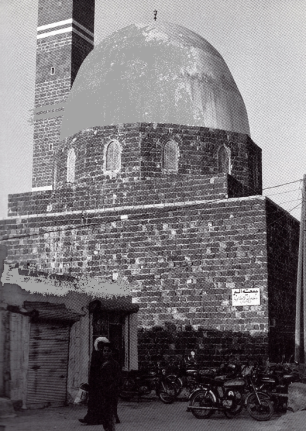
Mausoleum known as Maqam al-Imam in Salamiyya containing tombs of early Imams, erected around 1009. Image: The Ismailis An Illustrated History
In 1090, anticipating the end of the Fatimid Caliphate, Hasan Sabbah acquired the fortress of Alamut in Persia. Over the next 150 years, numerous fortresses were acquired in Persia and Syria for the settlement of Ismailis for their survival in these troubled regions, and freedom to organise and practise their faith.
In early twelfth century, Hasan Sabbah sent the first da’is to Syria. The success of the da’is in the region was slow due to a variety of issues including the majority Sunni population, and the infertile land where the Nizaris were residing causing many to migrate to scattered villages in order to earn a living through farming. Furthermore, the invasions by the Templars on Ismaili territories forcing them to pay dues, as well as the disputes within the community added to the complexity of issues. In 1162, Imam Hasan ala dhikrihi’l-salam (r.1162-1166) sent Sinan, “one of the most powerful and energetic da’is to be his deputy in Syria” (Mirza, Syrian Ismailism p 22).
A skillful strategist and a master of the art of diplomacy, Sinan promptly ended the internal dissensions and re-organised the da’wa. He played a prominent role in the regional politics of his time in order to safeguard the security and independence of the Nizari Ismailis. In the three decades that he was chief da’i of Syria, Sinan led the Nizari Ismailis to the peak of power and fame until his death in 1193.
After the fall of Alamut to the Mongols in 1256, the Syrian Ismailis came under Mamluk rule (1250-1517) and subsequently under Ottoman rule (1300-1922).
When Mawlana Sultan Muhammad Shah succeeded to the Imamat in 1885, the Ismailis of Syria “were living under circumstances that were drastically different from those of other Ismaili communities. Until the second half of the 19th century, the bulk of the Syrian Ismailis acknowledged the Muhammad Shahi line of the Nizari Ismaili Imams” (The Ismailis: An Illustrated History p 224).
Muhammad Shahi and Qasim Shahi Split
Upon the death of Imam Shams al-Din Muhammad around 1310, a dispute over his successor, between his sons Ala al-Din Muhammad and Qasim Shah, split the Nizari Ismaili community. Those who supported Ala al-Din Mu’min Shah came to be known as Muhammad Shahis (or Mu’minis). This line of Imams acquired large followings in northern Persia, Central Asia, and Syria. But they lost contact with the last Imam of that line in 1796 and failed to locate any of his descendants. At that time, the Ismailis of Syria switched their allegiance to the Qasim Shahi line of Imams, then represented by Mawlana Sultan Muhammad Shah. With the exception of a small group, the Syrian Ismailis recognised Mawlana Sultan Muhammad Shah as their Imam (Daftary, Dictionary of the Ismailis p 139).

Image: Daftary, The Ismaii Imams
“Until the 20th century, the Ismailis of Syria were subjects of the Ottomans [ca. 1299-1924], to whom they paid the relevant taxes and who ultimately controlled relations among the various religious communities…But rivalries between the two main leading Ismaili families, centred at Qadmus and Masyaf, weakened the community…” (The Ismailis An Illustrated History p 224).
In 1843, the amir of Qadmus, Amir Isma’il b. Amir Muhammad, obtained permission from the Ottomans to restore Salamiyya, then in ruins, for the permanent settlement of the Syrian Ismailis. Among the very first settlers were Ismailis who benefited from a general Ottoman policy of the time which granted amnesty to those willing to settle in areas that were rich farmland where the villages had been deserted for several generations. Over time, Salamiyya became an important agricultural centre, cultivating a variety of crops including wheat and legumes.
In a letter sent in 1890, preserved in the archives of the Ismailis Council in Salamiyya, Mawlana Sultan Muhammad Shah appointed Shaykh Sulayman al-Hajj as their mukhi, “introducing the Khoja religious terminology into Syria” (Douwes, A Modern History of the Ismailis p 29, p 41 n 18). Upon his death, Shaykh Ahmad, who reportedly spent a year in Bombay before returning to Syria, was appointed as mukhi. He faced much resistance when he attempted to introduce new teachings and rituals. “However, he is said to have argued that the Imam sought to emphasize the inner spirituality of the rituals” (Douwes, A Modern History of the Ismailis p 27).
Mawlana Sultan Muhammad Shah had sent his son Prince Aly Khan (d.1960) on regular visits to Syria, beginning in 1931, to Salamiyya and Khawabi, where he opened the Muhamadiyya school (Douwes, A Modern History of the Ismailis p 38). Prince Aly Khan, who was decorated with the Legion of Honour in 1950 for his military service in the Allied Forces and elected to the UN General Assembly in 1958, played a vital role in the development of the Ismailis of Syria. Prince Aly Khan was eventually buried (in 1972) in a mausoleum next to the jamatkhana in Salamiyya, as per his wishes.
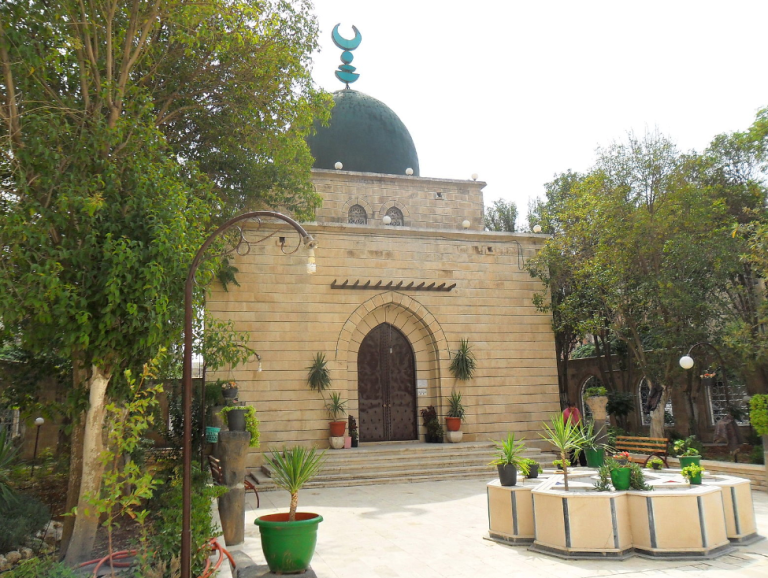
Mausoleum of Aly Khan in Salamiyya, Syria. Image: Wikemedia Commons
Most of the Ismailis of Syria today are descendants of those who had restored the town in the mid-nineteenth century. In 1951, Mawlana Sultan Muhammad Shah visited Salamiyya, where he founded several schools as well as an agriculture institution.
The fortress of Masyaf, the most important stronghold in Syria, was restored and conserved by Aga Khan Trust for Culture in 2004.
Masyaf Salamiyya
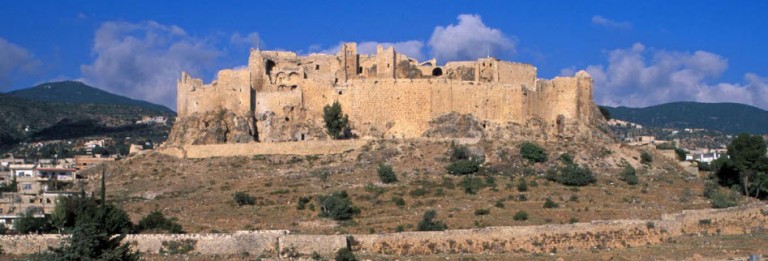
Masyaf. Image: Archnet
Mawlana Hazar Imam visited Salamiyya for the first time as Imam on July 27, 1959.
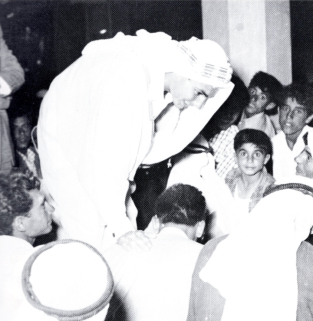
Mawlana Hazar Imam in Salamiyya, Syria, 1959. Image: 25 Years in Pictures, Islamic Publications Ltd., London, 1983
During his Golden Jubilee visit to Syria in 2008, Mawlana Hazar Imam witnessed the signing of agreements between the Aga Khan Development Network and the Government of Syria for economic, education, and cultural developments.
Sources:
Farhad Daftary and Azim Nanji, The Ismailis and their Role in the History of Medieval Syria and the Near East, The Institute of Ismaili Studies
Farhad Daftary, The Ismaili Imams, I.B. Tauris in association with The Institute of Ismaili Studies, London, 2020
Nasseh Ahmad Mirza, Syrian Ismailism: The Ever Living Line of Imamate. Cornwall, Curzon Press, 1997
Restoration projects in Syria Aga Khan Development Network
https://nimirasblog.wordpress.com/2021/ ... imid-time/
Posted by Nimira Dewji
Salamiyya (Salamieh), in Syria, played an important role in early Ismaili history as the secret headquarters of the da’wa in pre-Fatimid time.
Imam Muhammad b. Ismail succeeded his father to the Imamat around 765, at the age of twenty-six during a turbulent time in Medina, due to the dispute over the successors of his grandfather and father as well as anti-Alid Abbasid policies. Shortly after 766, Imam Muhammad b. Isma’il left Medina for the east in order to escape persecution, initiating the dawr al-satr, ‘period of concealment’ in early Ismaili history. Imam evidently spent the later part of his life in Khuzistan, in southwestern Persia, where he had some followers and from where he dispatched da’is to adjoining areas in Persia and southern Iraq.
The success of the da’is began to arouse the hostility of the local authorities, who attempted to arrest Imam when his identity was disclosed. Imam migrated to Salamiyya in 870, then a small town far from the major urban centres where visits from his da’is could not be easily noticed by the authorities.
It was in Salamiyya that his next three successors were able to establish secret headquarters of the da’wa. However, when events became turbulent, Imam al-Mahdi left the city in 902, eventually settling in Morocco in North Africa. In 909, Imam al-Mahdi established the Fatimid caliphate in North Africa, thereby ending the dawr al-satr in early Ismaili history.

Mausoleum known as Maqam al-Imam in Salamiyya containing tombs of early Imams, erected around 1009. Image: The Ismailis An Illustrated History
In 1090, anticipating the end of the Fatimid Caliphate, Hasan Sabbah acquired the fortress of Alamut in Persia. Over the next 150 years, numerous fortresses were acquired in Persia and Syria for the settlement of Ismailis for their survival in these troubled regions, and freedom to organise and practise their faith.
In early twelfth century, Hasan Sabbah sent the first da’is to Syria. The success of the da’is in the region was slow due to a variety of issues including the majority Sunni population, and the infertile land where the Nizaris were residing causing many to migrate to scattered villages in order to earn a living through farming. Furthermore, the invasions by the Templars on Ismaili territories forcing them to pay dues, as well as the disputes within the community added to the complexity of issues. In 1162, Imam Hasan ala dhikrihi’l-salam (r.1162-1166) sent Sinan, “one of the most powerful and energetic da’is to be his deputy in Syria” (Mirza, Syrian Ismailism p 22).
A skillful strategist and a master of the art of diplomacy, Sinan promptly ended the internal dissensions and re-organised the da’wa. He played a prominent role in the regional politics of his time in order to safeguard the security and independence of the Nizari Ismailis. In the three decades that he was chief da’i of Syria, Sinan led the Nizari Ismailis to the peak of power and fame until his death in 1193.
After the fall of Alamut to the Mongols in 1256, the Syrian Ismailis came under Mamluk rule (1250-1517) and subsequently under Ottoman rule (1300-1922).
When Mawlana Sultan Muhammad Shah succeeded to the Imamat in 1885, the Ismailis of Syria “were living under circumstances that were drastically different from those of other Ismaili communities. Until the second half of the 19th century, the bulk of the Syrian Ismailis acknowledged the Muhammad Shahi line of the Nizari Ismaili Imams” (The Ismailis: An Illustrated History p 224).
Muhammad Shahi and Qasim Shahi Split
Upon the death of Imam Shams al-Din Muhammad around 1310, a dispute over his successor, between his sons Ala al-Din Muhammad and Qasim Shah, split the Nizari Ismaili community. Those who supported Ala al-Din Mu’min Shah came to be known as Muhammad Shahis (or Mu’minis). This line of Imams acquired large followings in northern Persia, Central Asia, and Syria. But they lost contact with the last Imam of that line in 1796 and failed to locate any of his descendants. At that time, the Ismailis of Syria switched their allegiance to the Qasim Shahi line of Imams, then represented by Mawlana Sultan Muhammad Shah. With the exception of a small group, the Syrian Ismailis recognised Mawlana Sultan Muhammad Shah as their Imam (Daftary, Dictionary of the Ismailis p 139).

Image: Daftary, The Ismaii Imams
“Until the 20th century, the Ismailis of Syria were subjects of the Ottomans [ca. 1299-1924], to whom they paid the relevant taxes and who ultimately controlled relations among the various religious communities…But rivalries between the two main leading Ismaili families, centred at Qadmus and Masyaf, weakened the community…” (The Ismailis An Illustrated History p 224).
In 1843, the amir of Qadmus, Amir Isma’il b. Amir Muhammad, obtained permission from the Ottomans to restore Salamiyya, then in ruins, for the permanent settlement of the Syrian Ismailis. Among the very first settlers were Ismailis who benefited from a general Ottoman policy of the time which granted amnesty to those willing to settle in areas that were rich farmland where the villages had been deserted for several generations. Over time, Salamiyya became an important agricultural centre, cultivating a variety of crops including wheat and legumes.
In a letter sent in 1890, preserved in the archives of the Ismailis Council in Salamiyya, Mawlana Sultan Muhammad Shah appointed Shaykh Sulayman al-Hajj as their mukhi, “introducing the Khoja religious terminology into Syria” (Douwes, A Modern History of the Ismailis p 29, p 41 n 18). Upon his death, Shaykh Ahmad, who reportedly spent a year in Bombay before returning to Syria, was appointed as mukhi. He faced much resistance when he attempted to introduce new teachings and rituals. “However, he is said to have argued that the Imam sought to emphasize the inner spirituality of the rituals” (Douwes, A Modern History of the Ismailis p 27).
Mawlana Sultan Muhammad Shah had sent his son Prince Aly Khan (d.1960) on regular visits to Syria, beginning in 1931, to Salamiyya and Khawabi, where he opened the Muhamadiyya school (Douwes, A Modern History of the Ismailis p 38). Prince Aly Khan, who was decorated with the Legion of Honour in 1950 for his military service in the Allied Forces and elected to the UN General Assembly in 1958, played a vital role in the development of the Ismailis of Syria. Prince Aly Khan was eventually buried (in 1972) in a mausoleum next to the jamatkhana in Salamiyya, as per his wishes.

Mausoleum of Aly Khan in Salamiyya, Syria. Image: Wikemedia Commons
Most of the Ismailis of Syria today are descendants of those who had restored the town in the mid-nineteenth century. In 1951, Mawlana Sultan Muhammad Shah visited Salamiyya, where he founded several schools as well as an agriculture institution.
The fortress of Masyaf, the most important stronghold in Syria, was restored and conserved by Aga Khan Trust for Culture in 2004.
Masyaf Salamiyya

Masyaf. Image: Archnet
Mawlana Hazar Imam visited Salamiyya for the first time as Imam on July 27, 1959.

Mawlana Hazar Imam in Salamiyya, Syria, 1959. Image: 25 Years in Pictures, Islamic Publications Ltd., London, 1983
During his Golden Jubilee visit to Syria in 2008, Mawlana Hazar Imam witnessed the signing of agreements between the Aga Khan Development Network and the Government of Syria for economic, education, and cultural developments.
Sources:
Farhad Daftary and Azim Nanji, The Ismailis and their Role in the History of Medieval Syria and the Near East, The Institute of Ismaili Studies
Farhad Daftary, The Ismaili Imams, I.B. Tauris in association with The Institute of Ismaili Studies, London, 2020
Nasseh Ahmad Mirza, Syrian Ismailism: The Ever Living Line of Imamate. Cornwall, Curzon Press, 1997
Restoration projects in Syria Aga Khan Development Network
https://nimirasblog.wordpress.com/2021/ ... imid-time/
From Salamiyya to Sijilmasa, Imam al-Mahdi made a fateful journey to establish the Fatimid caliphate
Posted by Nimira Dewji
Muhammad b. Ismail, the seventh Imam of the Ismailis and the eldest son of Isma’il b. Ja’far al-Sadiq, succeeded his father to the Imamat during a turbulent time in Medina, due to the dispute over the successors of his grandfather and father as well as anti-Alid Abbasid policies. Shortly after 766, Imam left Medina for the east in order to escape persecution, initiating the dawr al-satr, ‘period of concealment’ in early Ismaili history.
For almost a century after Muhammad b. Isma’il, the hereditary Alid Imams did not openly lay claim to the Ismaili Imamat; their whereabouts were known to a few trusted da’is (The Ismailis An Illustrated History p 67).
Abd Allah b. Husayn al-Mahdi, the eleventh Ismaili Imam was born in 873 (or 874) in Askar Mukram in southwestern Persia. He was eight years old when his father died, having designated him as his successor. Due to his young age, his paternal uncle Abu Ali Muhammad b. Ahmad, had been appointed as his guardian. The uncle had attempted several times to usurp the leadership for his sons, and perhaps for himself.
At an unknown date, in the first half of the ninth century, Imam al-Mahdi found refuge in Salamiyya, Syria, where he established contact with his da’is, posing as a merchant. Henceforth, Salamiyya served as the secret headquarters of the Ismaili da’wa, which had spread to many regions including Yaman, Bahrayn, Egypt, and Sind in the Indian subcontinent.
A premature campaign by a da’i to install Imam al-Mahdi to a Fatimid state in Syria, without Imam’s authorisation, compromised the Imam’s position, revealing his true identity and place of residence. In order to escape Abbasid persecution, Imam al-Mahdi secretly left Salamiyya in 902, accompanied by his son al-Qa’im, his chamberlain Ja’far b. Ali, the chief da’i Firuz, and a few attendants. Imam first went to Ramla, where he stayed for some time, before continuing his journey to Fustat, Egypt, where he arrived in 903, continuing to disguise as a merchant. In Fustat, Imam met the da’i Abu Ali who had been preaching Ismailism on his instructions for a number of years. At this time, the da’i Firuz deserted the Imam, fleeing to Yaman and instigating a revolt against Imam al-Mahdi (Daftary, The Ismailis Their history and doctrines p 134).
Imam was once again forced to leave. He travelled to the Maghrib1 where the loyal da’i Abu Abd Allah al-Shi’i had already achieved much success in the region, which was a stronghold of Maliki Sunnism. Imam Ja’far al-Sadiq had sent two da’is to this region around 762 to spread Ismailism. “More than a century later in [893], the pioneering da’i Abu Abd Allah al-Shi’i arrived in the mountainous Berber region of eastern Algeria. He lived among the Kutama tribesmen for nearly sixteen years, preaching the Ismaili doctrine, uniting them under his leadership….” Thus, he was able to overthrow the ruling dynasty, “making it possible in [902]for the Ismaili Imam Abd Allah… to undertake a long and hazardous journey from Syria to North Africa” (Jiwa, Towards a Shi’i Mediterranean Empire p 7)
In Fustat, Abd Allah al-Mahdi joined a caravan of merchants travelling to the Maghrib. In Tripoli, he dispatched the da’i Abu’l Abbas Muhammad to inform his younger brother, al-Shi’i, of al-Mahdi’s imminent arrival. However, the identity of Abu’l Abbas was discovered in Qayrawan (Kairouan), where he was arrested and imprisoned by the Aghlabids who governed in the name of the Abbasids over Ifriqiya [modern–day eastern Algeria and Tunisia] from 800 to 909.
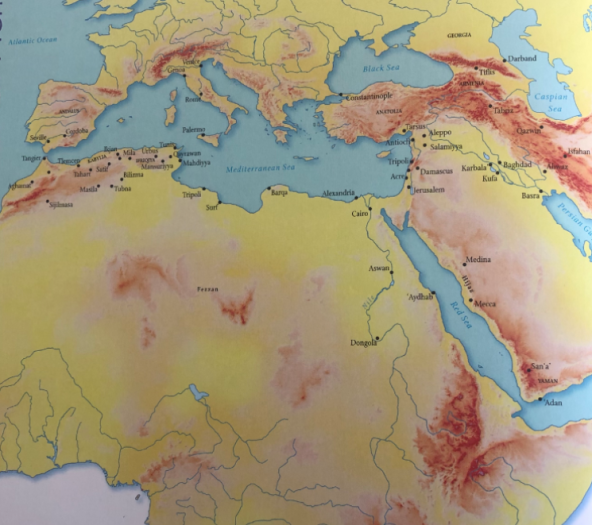
Fatimid Realms. Source: The Ismailis An Illustrated History
Once again, Imam al-Mahdi was obliged to change his plans. He joined another caravan, finally arriving in the remote town of Sijilmasa (today’s Rissani in southeastern Morocco), which lay on an important trading route across the desert. Imam lived quietly there for four years (905-909) as one of the towns many merchants, also maintaining contact with da’i al-Shi’i, who was then preparing to launch the final military phase of his operations in the Maghrib.
By 903, al-Shi’i had commenced his conquest of North Africa and in March 909, he entered the palace city of Raqqada where he governed on behalf of Imam al-Mahdi for almost a year, “issuing a general amnesty for the people and adding blessings on the ahl al-bayt in the khutba, or sermon, at the Friday prayers” (Daftary, The Ismaili Imams p 70).
In January 910, Imam al-Mahdi was publically acclaimed as ruler and on the following day, the khutba was pronounced for the first time in the mosques of Qayrawan in the name of Imam al-Mahdi; a manifesto was read out from the pulpits announcing that the caliphate had finally come to be vested in the ahl al-bayt. The Shi’i caliphate of the Fatimids officially commenced in North Africa. The new caliphate was named as Fatimid, derived from the name of the Prophet’s daughter Fatima, to whom al-Mahdi and his successors traced back their Alid ancestry.
In order to gain access to the Mediterranean, Imam founded the town of Mahdiyya, named after himself, to where he transferred his capital in 921. Mahdiyya was equipped with a large shipyard which enabled the Fatimids to possess a powerful fleet. The earliest architecture of Mahdiyya, including the mosque built by the Imam, are still preserved.
mosque jami kabir mahdiyya mahdia
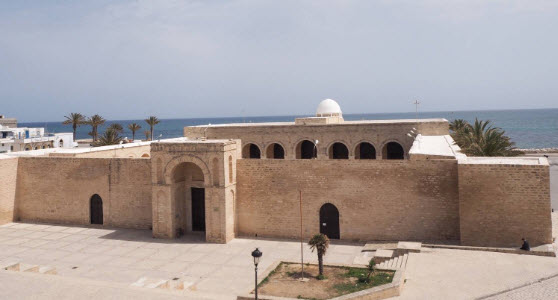
Jami al-Kabir, Great Mosque of Mahdiyya (Mahdia). Photo: Russell Harris, Archnet
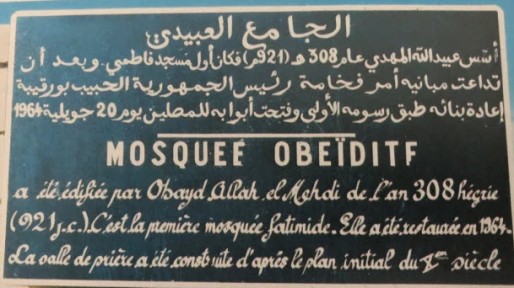
A plaque stating the mosque was built by Obayd Allah el-Mehdi in the year 308 A.H. (921 CE), restored in 1964. The prayer hall has been constructed according to the original 10th century design. Photo: Ilm, Vol 8, Dec 1982-Feb 1983
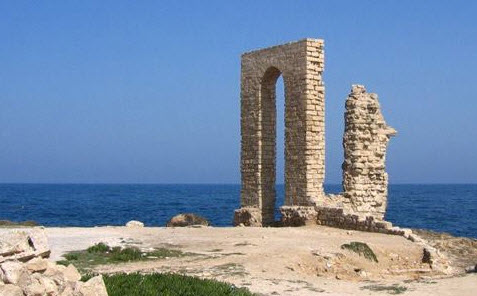
Ruins at Mahdiyya. Photo: The Institute of Ismaili Studies
The prominent scholar of the eleventh century Ahmed al-Naysaburi, who worked during the time of Imam al-Aziz, wrote numerous works. His Kitab Istitar al-imam wa tafarruq al-du’at fi’l-jaza’ir li-talabi-hi (The Book of the Concealment of the Imam and the Departure of the da‘is to different “islands” in search of him) is considered “a central work in medieval Ismaili thought” (The Ismailis An Illustrated History p 99). The text provides details about the hardships faced by Imam al-Mahdi when he fled to North Africa.

Al-Naysaburi’s Kitab al-Istitar al-imama. Source: The Ismailis: An Illustrated History
Having laid the foundation to Fatimid rule in North Africa, Imam al-Mahdi died in 934, after a caliphate of twenty-five years and an Imamat of at least thirty-five years. He was succeeded by his son al-Qa’im, who was born in Salamiyya and had accompanied his father on his fateful journey to Sijilmasa and then to Qayrawan.
Imam al-Qa’im continued his father’s policies for territorial expansion, and enjoyed relative peace in North Africa, although towards the end of his reign, Abu Yazid and his supporters launched an anti-Fatimid rebellion. Imam al-Qa’im succeeded in repelling the armies in their attempts to storm the capital. Imam al-Qa’im died in 946, after reign of twelve years. He was succeeded by his son al-Mansur.
Abu Tahir Isma’il al-Mansur was born in Raqqada in 914, and came to power amidst widespread rebellion of Abu Yazid. He built a new royal city, Mansuriyya, named after him. The city, to which Imam moved his capital in 948, served as the Fatimid capital until it was moved to the new Egyptian city founded by his successor Imam al-Mu’izz. Imam al-Mahdi died in 953 after an eventful caliphate and Imamat of seven years.
1 Lit. ‘the place of sunset.’ In mediaeval Muslim geography it referred to the western part of North Africa (present–day Morocco, Algeria, and Tunisia)
Sources:
Farhad Daftary, Zulfikar Hirji, The Ismailis An Illustrated History, Azimuth Editions in association with The Institute of Ismaili Studies, London, 2008
Farhad Daftary, The Ismailis Their history and doctrines, Cambridge University Press, 1990
Farhad Daftary, The Ismaili Imams, I.B. Tauris in association with The Institute of Ismaili Studies, London, 2020
Shainool Jiwa, Towards a Shi’i Mediterranean Empire, I.B. Tauris in association with The Institute of Ismaili Studies, London, 2009
Al-Mahdiyya, The Institute of Ismaili Studies
Jami al-Kabir, Mahdia, Tunisia, Archnet
https://nimirasblog.wordpress.com/2021/ ... caliphate/
Posted by Nimira Dewji
Muhammad b. Ismail, the seventh Imam of the Ismailis and the eldest son of Isma’il b. Ja’far al-Sadiq, succeeded his father to the Imamat during a turbulent time in Medina, due to the dispute over the successors of his grandfather and father as well as anti-Alid Abbasid policies. Shortly after 766, Imam left Medina for the east in order to escape persecution, initiating the dawr al-satr, ‘period of concealment’ in early Ismaili history.
For almost a century after Muhammad b. Isma’il, the hereditary Alid Imams did not openly lay claim to the Ismaili Imamat; their whereabouts were known to a few trusted da’is (The Ismailis An Illustrated History p 67).
Abd Allah b. Husayn al-Mahdi, the eleventh Ismaili Imam was born in 873 (or 874) in Askar Mukram in southwestern Persia. He was eight years old when his father died, having designated him as his successor. Due to his young age, his paternal uncle Abu Ali Muhammad b. Ahmad, had been appointed as his guardian. The uncle had attempted several times to usurp the leadership for his sons, and perhaps for himself.
At an unknown date, in the first half of the ninth century, Imam al-Mahdi found refuge in Salamiyya, Syria, where he established contact with his da’is, posing as a merchant. Henceforth, Salamiyya served as the secret headquarters of the Ismaili da’wa, which had spread to many regions including Yaman, Bahrayn, Egypt, and Sind in the Indian subcontinent.
A premature campaign by a da’i to install Imam al-Mahdi to a Fatimid state in Syria, without Imam’s authorisation, compromised the Imam’s position, revealing his true identity and place of residence. In order to escape Abbasid persecution, Imam al-Mahdi secretly left Salamiyya in 902, accompanied by his son al-Qa’im, his chamberlain Ja’far b. Ali, the chief da’i Firuz, and a few attendants. Imam first went to Ramla, where he stayed for some time, before continuing his journey to Fustat, Egypt, where he arrived in 903, continuing to disguise as a merchant. In Fustat, Imam met the da’i Abu Ali who had been preaching Ismailism on his instructions for a number of years. At this time, the da’i Firuz deserted the Imam, fleeing to Yaman and instigating a revolt against Imam al-Mahdi (Daftary, The Ismailis Their history and doctrines p 134).
Imam was once again forced to leave. He travelled to the Maghrib1 where the loyal da’i Abu Abd Allah al-Shi’i had already achieved much success in the region, which was a stronghold of Maliki Sunnism. Imam Ja’far al-Sadiq had sent two da’is to this region around 762 to spread Ismailism. “More than a century later in [893], the pioneering da’i Abu Abd Allah al-Shi’i arrived in the mountainous Berber region of eastern Algeria. He lived among the Kutama tribesmen for nearly sixteen years, preaching the Ismaili doctrine, uniting them under his leadership….” Thus, he was able to overthrow the ruling dynasty, “making it possible in [902]for the Ismaili Imam Abd Allah… to undertake a long and hazardous journey from Syria to North Africa” (Jiwa, Towards a Shi’i Mediterranean Empire p 7)
In Fustat, Abd Allah al-Mahdi joined a caravan of merchants travelling to the Maghrib. In Tripoli, he dispatched the da’i Abu’l Abbas Muhammad to inform his younger brother, al-Shi’i, of al-Mahdi’s imminent arrival. However, the identity of Abu’l Abbas was discovered in Qayrawan (Kairouan), where he was arrested and imprisoned by the Aghlabids who governed in the name of the Abbasids over Ifriqiya [modern–day eastern Algeria and Tunisia] from 800 to 909.

Fatimid Realms. Source: The Ismailis An Illustrated History
Once again, Imam al-Mahdi was obliged to change his plans. He joined another caravan, finally arriving in the remote town of Sijilmasa (today’s Rissani in southeastern Morocco), which lay on an important trading route across the desert. Imam lived quietly there for four years (905-909) as one of the towns many merchants, also maintaining contact with da’i al-Shi’i, who was then preparing to launch the final military phase of his operations in the Maghrib.
By 903, al-Shi’i had commenced his conquest of North Africa and in March 909, he entered the palace city of Raqqada where he governed on behalf of Imam al-Mahdi for almost a year, “issuing a general amnesty for the people and adding blessings on the ahl al-bayt in the khutba, or sermon, at the Friday prayers” (Daftary, The Ismaili Imams p 70).
In January 910, Imam al-Mahdi was publically acclaimed as ruler and on the following day, the khutba was pronounced for the first time in the mosques of Qayrawan in the name of Imam al-Mahdi; a manifesto was read out from the pulpits announcing that the caliphate had finally come to be vested in the ahl al-bayt. The Shi’i caliphate of the Fatimids officially commenced in North Africa. The new caliphate was named as Fatimid, derived from the name of the Prophet’s daughter Fatima, to whom al-Mahdi and his successors traced back their Alid ancestry.
In order to gain access to the Mediterranean, Imam founded the town of Mahdiyya, named after himself, to where he transferred his capital in 921. Mahdiyya was equipped with a large shipyard which enabled the Fatimids to possess a powerful fleet. The earliest architecture of Mahdiyya, including the mosque built by the Imam, are still preserved.
mosque jami kabir mahdiyya mahdia

Jami al-Kabir, Great Mosque of Mahdiyya (Mahdia). Photo: Russell Harris, Archnet

A plaque stating the mosque was built by Obayd Allah el-Mehdi in the year 308 A.H. (921 CE), restored in 1964. The prayer hall has been constructed according to the original 10th century design. Photo: Ilm, Vol 8, Dec 1982-Feb 1983

Ruins at Mahdiyya. Photo: The Institute of Ismaili Studies
The prominent scholar of the eleventh century Ahmed al-Naysaburi, who worked during the time of Imam al-Aziz, wrote numerous works. His Kitab Istitar al-imam wa tafarruq al-du’at fi’l-jaza’ir li-talabi-hi (The Book of the Concealment of the Imam and the Departure of the da‘is to different “islands” in search of him) is considered “a central work in medieval Ismaili thought” (The Ismailis An Illustrated History p 99). The text provides details about the hardships faced by Imam al-Mahdi when he fled to North Africa.

Al-Naysaburi’s Kitab al-Istitar al-imama. Source: The Ismailis: An Illustrated History
Having laid the foundation to Fatimid rule in North Africa, Imam al-Mahdi died in 934, after a caliphate of twenty-five years and an Imamat of at least thirty-five years. He was succeeded by his son al-Qa’im, who was born in Salamiyya and had accompanied his father on his fateful journey to Sijilmasa and then to Qayrawan.
Imam al-Qa’im continued his father’s policies for territorial expansion, and enjoyed relative peace in North Africa, although towards the end of his reign, Abu Yazid and his supporters launched an anti-Fatimid rebellion. Imam al-Qa’im succeeded in repelling the armies in their attempts to storm the capital. Imam al-Qa’im died in 946, after reign of twelve years. He was succeeded by his son al-Mansur.
Abu Tahir Isma’il al-Mansur was born in Raqqada in 914, and came to power amidst widespread rebellion of Abu Yazid. He built a new royal city, Mansuriyya, named after him. The city, to which Imam moved his capital in 948, served as the Fatimid capital until it was moved to the new Egyptian city founded by his successor Imam al-Mu’izz. Imam al-Mahdi died in 953 after an eventful caliphate and Imamat of seven years.
1 Lit. ‘the place of sunset.’ In mediaeval Muslim geography it referred to the western part of North Africa (present–day Morocco, Algeria, and Tunisia)
Sources:
Farhad Daftary, Zulfikar Hirji, The Ismailis An Illustrated History, Azimuth Editions in association with The Institute of Ismaili Studies, London, 2008
Farhad Daftary, The Ismailis Their history and doctrines, Cambridge University Press, 1990
Farhad Daftary, The Ismaili Imams, I.B. Tauris in association with The Institute of Ismaili Studies, London, 2020
Shainool Jiwa, Towards a Shi’i Mediterranean Empire, I.B. Tauris in association with The Institute of Ismaili Studies, London, 2009
Al-Mahdiyya, The Institute of Ismaili Studies
Jami al-Kabir, Mahdia, Tunisia, Archnet
https://nimirasblog.wordpress.com/2021/ ... caliphate/